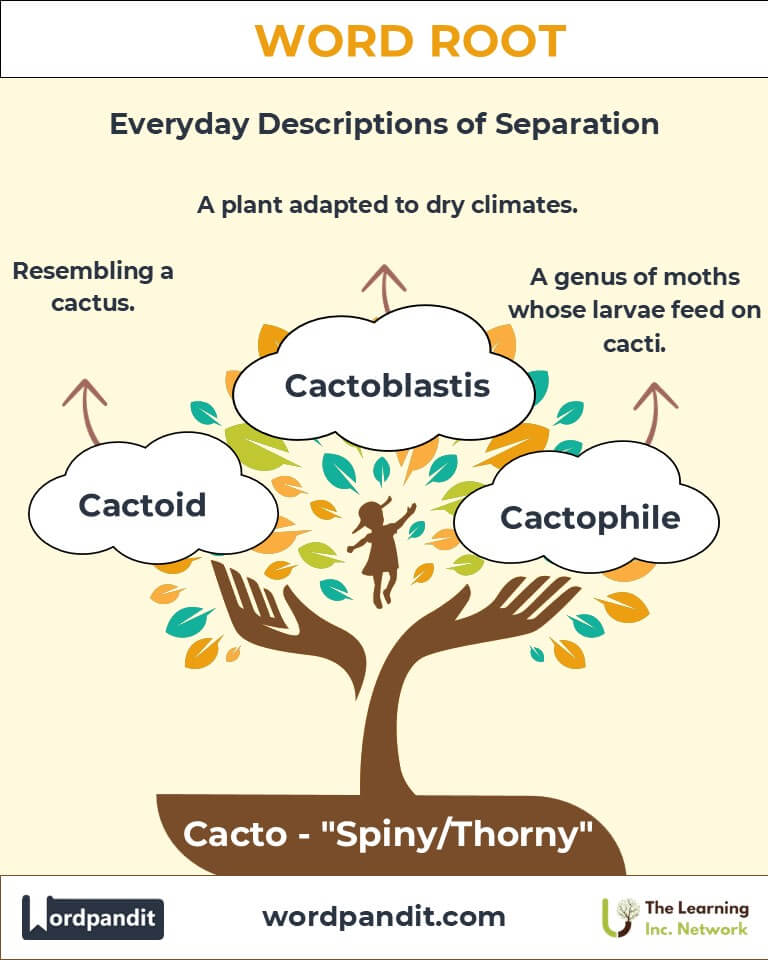Cacto: The Root of Thorny Wonders in Nature and Language
Discover the fascinating origins and applications of the word root "cacto," derived from the Greek word kaktos, meaning "spiny" or "thorny." This root forms the basis of terms that evoke resilience and adaptability in both natural and metaphorical landscapes.

Table of Contents
- Introduction: The Resilience of Cacto
- Etymology and Historical Journey
- Mnemonic: Unlocking the Power of Cacto
- Common Cacto-Related Terms
- Cacto Through Time
- Cacto in Specialized Fields
- Illustrative Story: Cacto in Action
- Cultural Significance of the Cacto Root
- The Cacto Family Tree
- FAQs about the Cacto Word Root
- Test Your Knowledge: Cacto Mastery Quiz
- Conclusion: The Timeless Resilience of Cacto
1. Introduction: The Resilience of Cacto
When you think of the word "cactus," images of arid deserts and resilient plants come to mind. The root "cacto," derived from the Greek kaktos (spiny plant), signifies adaptability and protection. Found in nature and various terminologies, this root captures the essence of endurance and survival.

2. Etymology and Historical Journey
The word kaktos originated in Ancient Greece, initially used to describe spiny plants like the cardoon. With the expansion of botanical studies during the Age of Exploration, the term was adopted into Latin and eventually English, becoming synonymous with cacti—the iconic desert plants. Over time, "cacto" has symbolized resilience in both literal and metaphorical senses.
3. Mnemonic: Unlocking the Power of Cacto
Imagine a cactus thriving in a scorching desert, its spines glinting in the sunlight—a perfect image of resilience and defense.
Mnemonic Device: “Cacto clings to life with spikes of strength!”
4. Common Cacto-Related Terms
- Cactus (KAK-tuhs): A spiny plant adapted to arid environments.
Example: "The cactus bloomed unexpectedly after the rains." - Cactaceous (kak-TAY-shuhs): Belonging to the cactus family.
Example: "Cactaceous plants are known for their unique water storage abilities." - Cactoid (KAK-toid): Resembling a cactus.
Example: "Succulents with cactoid features are popular in home decor." - Cactophile (KAK-toh-file): A person who loves cacti.
Example: "As a cactophile, she collected rare species from across the globe." - Cactoblastis (KAK-toh-blas-tis): A genus of moths whose larvae feed on cacti.
Example: "Cactoblastis moths were introduced to control invasive prickly pear species."
5. Cacto Through Time
- Cactus (16th Century): Borrowed from Latin, this term expanded to describe an entire family of plants in the Americas.
- Cactaceous (19th Century): Introduced during a surge in botanical classification efforts.
- Cactoblastis (20th Century): Associated with biological pest control, especially in Australia.
6. Cacto in Specialized Fields
- Botany:
Cactaceous: Classification of plants in the cactus family, central to xerophyte research. - Ecology:
Cactoblastis: A vital term in biological pest management studies. - Design:
Cactoid: Used in architecture and interior design to describe structures or decor mimicking cactus forms.
7. Illustrative Story: Cacto in Action
In a small village on the edge of a desert, a young girl named Aria planted a cactus in her garden. Years of drought tested its resilience, yet the cactus thrived, becoming a symbol of hope for the community. Inspired, Aria studied botany and introduced drought-resistant cactaceous plants to help farmers conserve water and sustain their crops. Her efforts transformed the region, proving that even the thorny can bring beauty and life.
8. Cultural Significance of the Cacto Root
Cacti are celebrated in cultures worldwide, representing endurance and protection. Indigenous peoples of the Americas revered them as sources of food and medicine. In modern times, cacti symbolize self-reliance and resilience, often featured in art, fashion, and design.

9. The Cacto Family Tree
- Spino- (Latin: spine):
- Spiny: Covered with spines.
- Spinous: Having sharp projections.
- Thorn- (Old English: thorn):
- Thorny: Full of difficulties (literal and metaphorical).
- Thorn: A sharp-pointed projection.
- Xero- (Greek: dry):
- Xerophyte: A plant adapted to dry climates.
- Xeriscape: Landscaping designed to reduce water use.
10.FAQs About the Cacto Word Root
Q: What does "cacto" mean?
A: "Cacto" means "spiny" or "thorny," derived from the Greek word kaktos. Originally used for spiny plants like the cardoon, it became associated with the cactus family and symbolizes resilience and protection.
Q: Are all succulents cactaceous?
A: No, not all succulents belong to the cactus family (Cactaceae). While all cacti are succulents, not all succulents have the unique features of cacti, such as areoles from which spines and flowers grow.
Q: What is a cactophile?
A: A cactophile is someone who loves cacti. These enthusiasts often collect, study, and care for cacti, appreciating their unique forms, spines, and flowers.
Q: How is "cactoid" used?
A: "Cactoid" refers to objects or plants that resemble cacti. For example, some succulents like euphorbias mimic the appearance of cacti but belong to a different botanical family.
Q: Why is Cactoblastis important?
A: The genus Cactoblastis includes moths whose larvae feed on cacti. Notably, Cactoblastis cactorum was used to control invasive prickly pear cacti in Australia, demonstrating the potential and risks of biological pest control.
11.Test Your Knowledge: Cacto Word Root Quiz
1. What does "cacto" mean?
2. What does "Cactaceous" describe?
3. What is a cactophile?
4. Which of the following moths targets cacti?
5. What does "Cactoid" mean?

12. Conclusion: The Timeless Resilience of Cacto
The root "cacto" exemplifies endurance and adaptability, evident in the plants it represents and the linguistic branches it has inspired. From botanical classifications to cultural metaphors, this root continues to remind us of nature’s power to thrive under challenging conditions. Let "cacto" inspire resilience and innovation in your pursuits!











